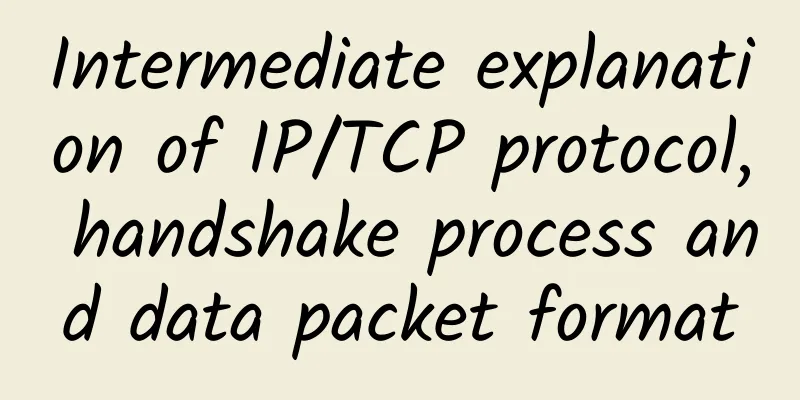Intermediate explanation of IP/TCP protocol, handshake process and data packet format

|
IP address definition: IP is known as Internet Protocol, which is a key underlying protocol used on the Internet. TCP/IP is a universal communication protocol that makes the Internet a network that allows different types of computers and different operating systems to be connected. Features: The IP protocol has the flexibility to adapt to a variety of network hardware and has almost no requirements for the underlying network hardware. Any network that can transmit binary data from one location to another can use the IP protocol to join the Internet. Require: For communication needs, IP software must be running on every computer connected to the Internet so that it is always ready to send or receive information. substance: The IP address is defined by the IP protocol and is represented by a 32-bit binary number (IPv4). The latest IPv6 protocol increases the IP address to 128 bits, which makes the IP address more widely used and can effectively solve the current shortage of IP addresses. However, the IPv6 protocol is still some distance away from practical application. Currently, most operating systems and application software are based on 32-bit IP addresses. composition: The 32-bit IP address (IPv4) is mainly divided into two parts, namely the prefix and the suffix. The prefix indicates the physical network to which the computer belongs (network number), and the suffix determines the only computer on the network (host number). That is: IP address = network number + host number Classification: On the Internet, each physical network has a unique network number. According to the network number, IP addresses can be divided into five categories, namely Class A, Class B, Class C, Class D and Class E. Among them, Class A, Class B and Class C belong to the basic class, Class D is used for multicast transmission, and Class E belongs to the reserved class. The ranges of various IP addresses are as follows: Network address: In an IP address, a host address of 0 indicates a network address, for example: 128.111.0.0. Broadcast address (all '1' address): An address with all 1s after the network number indicates a broadcast address. Return address: 127.0.0.1 represents the loopback address, also called the local address, which is used for testing. All '0' addresses: Corresponds to the current host. ABC main type address reserved area: Domain Name System (DNS) The Domain Name System is a distributed database that provides the service of converting host names (i.e. URLs) into IP addresses. RFC Request For Comments (RFC) is a series of numbered documents that collect information about the Internet, as well as software files from the UNIX and Internet communities, including standard documents for the TCP/IP protocol. Port Ports include two types: logical ports and physical ports. A physical port refers to a physically existing port, such as an interface on an ADSL Modem, hub, switch, or router that is used to connect to other network devices, such as an RJ-45 port, SC port, and so on. Logical ports refer to ports used to distinguish services in a logical sense, such as service ports in the TCP/IP protocol. The port number ranges from 0 to 65535, such as port 80 for web browsing services and port 21 for FTP services. Port Code Since there are a large number of physical ports and logical ports, a total of (2^16-1), in order to distinguish the ports, each port is numbered, which is the port number. The port number of the transport layer is divided into the port number used by the server (0-49151 [well-known port number (0-1023), registered port number (1024-49151)]) and the port number used by the client (49151-65535). Commonly used network port numbers - Jiang Yake's blog - CSDN blog Application Programming Interface (API) API is a set of predefined functions. Common programming interfaces include socket and TLI. Its functions mainly include: remote procedure call (RPC), standard query language (SQL), file transfer and information delivery, etc. API can be applied to all computer platforms and operating systems. The interface part of the outline design document is simple and is generally divided into three parts: user interface, external interface and internal interface. The user interface only needs to briefly describe user operations and feedback results, etc.; the external interface briefly describes hardware input and output, network transmission protocol, etc.; the internal interface briefly describes the value transfer and data transfer between modules. Packet format Each layer of the TCP/IP protocol sends different data packets, the most common ones are IP packets, TCP packets, UDP packets and ICMP packets. IP Datagram: IP data packets are sent between IP protocols, mainly transmitted between Ethernet and Internet Protocol modules, providing linkless data transmission. The IP protocol does not guarantee the delivery of data packets, but sends data to the maximum extent possible. The IP protocol provides unreliable connectionless datagram transmission services. The services provided by the IP layer are realized through the encapsulation and decapsulation of datagrams by the IP layer. The IP protocol structure is defined as follows:
Note: In theory, the maximum length of an IP data packet is 655535 bytes, which is limited by the 16-bit total length field of the IP header. IP routing selection process: TCP Datagram: Transmission Control Protocol TCP is a common protocol that provides reliable data transmission. It is transmitted between the network protocol module and the TCP module. The TCP data packet is divided into two parts: TCP header and data. TCP data is encapsulated in IP data packets, similar to UDP, in the data part of IP data packets. The TCP header contains the source port, destination port, sequence number, confirmation sequence number, header length, codeword bits, window, checksum, urgent pointer, optional, padding bit and data area. When sending data, the application layer data is transmitted to the transport layer, and the TCP header is added to the data to form a packet. The message-type Internet layer IP data, if combined with the IP header, constitutes an IP data packet. The TCP header structure is defined as follows:
TCP provides a fully reliable, connection-oriented, full-duplex (including two independent and opposite connections) stream transmission service, allowing two applications to establish a connection, send data in the full-duplex direction, and then terminate the connection. Each TCP connection is reliably established and perfectly terminated, and all data is reliably transmitted before the termination occurs. The more famous concept of TCP is the three-way handshake, which means that the communicating parties exchange information three times in batches. The three-way handshake is a necessary and sufficient condition to ensure the determinism of information exchange between the communicating parties in the event of packet loss, duplication and delay. TCP/IP three-way handshake to establish a connection: The first handshake: client--sends----syn packet (seq=x)-----server--enters SYN_END state and waits for server confirmation; Second handshake: When the server receives the SYN packet, it must confirm the client's SYN (ack=x+1) and send a SYN packet (seq=x) at the same time, that is, a SYN+ACK packet. At this time, the server enters the SYN-RECV state; The third handshake: The client receives the SYN+ACK packet from the server and sends a confirmation packet ACK (ack=y+1) to the server. After this packet is sent, the client and server enter the ESTABLISHED state, complete the handshake, and establish the connection. Note: During the handshake, the packets sent do not include data; data transmission begins only after the connection is established. The TCP connection will be maintained until the connection is actively closed. Data transfer mechanism: 1. Timeout retransmission: This mechanism is used to ensure the reliability of TCP transmission. 2. Fast retransmission: After receiving continuous packet loss information, the sender immediately starts retransmission to save waiting time. 3. Flow control: TCP sliding window flow control. Sliding window can be a mechanism to improve TCP transmission efficiency. 4. Congestion control: Based on the entire network, the congestion strategy algorithm mainly includes: slow start, congestion avoidance, congestion occurrence, and fast recovery. TCP four-way handshake disconnection: First handshake: The master sends a FIN to notify the disconnected party: I am about to close the data transmission channel. At this time, the master can still receive data. Second handshake: After receiving the FIN packet, the disconnected party sends an ACK to the active party, confirming that the sequence number is the received sequence number + 1 (the same as SNK, one FIN occupies one sequence number). The third handshake: The disconnected party sends a FIN to notify the active party: I am about to close the data transmission channel. The fourth handshake: After receiving the FIN, the active party sends an ACK to the disconnected party, confirming that the sequence number is the received sequence number + 1, and the two sides of the channel are disconnected. Four handshakes are completed. Note: Reliable transmission service software is all data stream oriented. UDP Packet: User Datagram Protocol (UDP) is a connectionless protocol. After adopting this protocol, two applications do not need to establish a connection. It provides one-way data transmission service for applications. UDP protocol works between Internet protocol module and UDP module. It does not provide error recovery and data retransmission. Therefore, applications using UDP protocol are relatively complex, such as DNS (Domain Name Resolution Service) application. The header structure of UDP data packet is as follows:
UDP data packet is divided into two parts: pseudo header and header. The header contains the original IP address, target IP address, protocol word, UDP length, source port, destination port, packet length, checksum, and data area, and is set for calculation and verification. The pseudo header contains some fields of the IP header, and its purpose is to let UDP check twice whether the data reaches the destination correctly. When using the UDP protocol, the protocol word is 17, and the packet length includes the total length of the header and data area, with a minimum of 8 bytes. The checksum is in units of 16, and each bit is complemented (the first bit is the sign bit), the sum is added, and then complemented. Most systems now provide a default UDP datagram that can read and write more than 8192 bytes (this default value is used because 8192 is the default value for NFS to read and write user data). Because the UDP protocol is error-controlled, the sending process is similar to the IP protocol, that is, IP packets are grouped, and then the ARP protocol is used to resolve the physical address and finally sent. UDP network sends and receives data: ICMP Packets ICMP protocol is called Internet Control Packet Protocol. As a subsidiary protocol of IP protocol, ICMP protocol is used to exchange error packets and other important information with other hosts or routers. It can send the fault information of a device to other devices. The header structure of ICMP data packet is as follows:
|
<<: Is homogeneous competition among telecom operators serious?
>>: The Secret History of IPv6
Recommend
How does Huawei Software Development Cloud make DevOps a reality?
DevOps has transformed the workflow and tradition...
Linode: Cloud servers in 24 data centers around the world starting at $5/month, new users get $100 for free
It has been a long time since I shared informatio...
Global users' views on 5G: Five keys to commercial success
Recently, Ericsson Consumer Lab released the &quo...
IPv6 communication principle (1) - The network card startup process that cannot be ignored
Related article: IPv6 Series - 10 Common Problems...
RAKsmart: US servers starting from $30, Hong Kong servers/cluster servers pre-sale, US cluster servers/1-10Gbps bandwidth servers/high-defense servers special offers
There is only one month left in 2020, and RAKsmar...
LOCVPS: Hong Kong Confederation/Cloud VPS 40% off, 2GB memory package starting at 33 yuan per month
LOCVPS (Global Cloud) is an early established Chi...
What is edge computing? Why is it called the gas station in the era of smart IoT?
With the rapid development of the Internet of Thi...
You may not receive the verification code, or you may change your phone number... There are still troubles to torment you after porting your number to another network
"If you are not satisfied with a company, ta...
How far will 5G go on the road to industrial application?
[[377138]] 5G unmanned mines, 5G intelligent tran...
Comparison of 5G tariffs in China and South Korea: Which country’s users are the happiest?
Globally, South Korea was the first country to co...
If you want to work efficiently online, I suggest you use "Ruliu": project management and collaborative documents are all here
Have you adapted to the online working mode durin...
How does SD-WAN compare to VPN?
When enterprises compare SD-WAN vs. VPN services,...
Industry 4.0 is driving enterprise fiber access
Industry 4.0 has brought with it a wave of value-...
Summary of the third phase of 5G technology R&D trials: the newly added 2.6GHz frequency band is consistent with the 3.5GHz test results
On January 23, 2019, the IMT-2020 (5G) Promotion ...
![[6.18] V5.NET 20% off monthly payment for all independent servers, 30% off for specific models in Tsuen Wan, Hong Kong](/upload/images/67cabe8732fca.webp)








